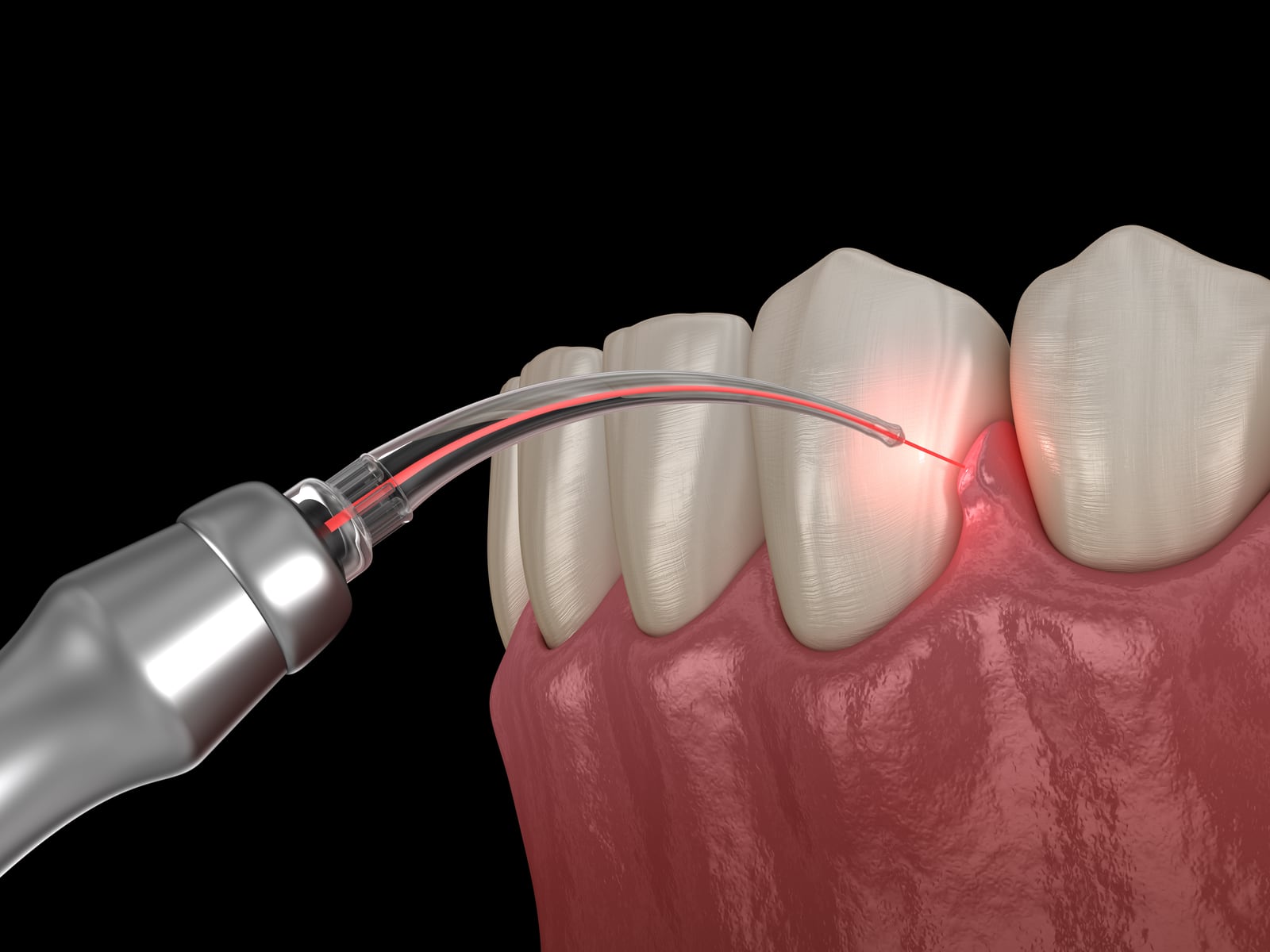About 47% of adults age 30 or older have some form of gum disease, also called periodontal disease, and the risk increases with age. At minimum, gum disease can give you bad breath. It may even make it painful to eat or drink – puffy, red gums can also be prone to bleeding.
Without proper care, periodontal disease can weaken and destroy the bones that support your teeth, leading to tooth loosening and ultimately tooth loss. It creates an uncontrolled population of bacteria that not only infects your mouth but can enter your bloodstream and cause heart disease. Periodontal disease is also associated with increased risk of diabetes, Alzheimer’s disease and Parkinson’s disease.
Today, patients have a new treatment option to help in the fight against gum disease.
Laser surgery is just one tool in our kit to improve your oral health – it works in conjunction with other methods to reduce discomfort and downtime so you can feel like yourself again faster.
Laser surgery can remove diseased or damaged tissue from around the gums without the use of sutures or scalpels. As a less-invasive option to traditional oral surgery, laser surgery:
- Leads to faster healing
- Reduces the risk of bleeding
- Has negligible post-operative discomfort
- Requires no downtime
Because laser technology is so versatile, the UT Southwestern dental and oral & maxillofacial surgery team uses it to remove benign lesions and treat a range of oral health conditions that traditionally require more invasive procedures.
How oral laser surgery works
“Laser” stands for light amplification by the stimulated emission of radiation. The device can be tuned to different intensities based on your condition and the type of treatment you need.

Using a special handheld device, a small amount of laser light energy heats the affected gum tissue to treat the conditions that are of concern to each patient. The device uses disposable tips to help prevent cross contamination, and the patient and the dentist will wear special glasses to protect the eyes from potentially harmful scattered light waves.
The laser distinguishes between diseased and healthy tissue by color. The light in the laser is attracted to darker pigmentation (melanin), which is identified in diseased tissue because of the unnaturally blood-filled features in periodontal disease and other oral conditions.
For periodontal disease treatment, the clinician uses the laser to vaporize unhealthy gum tissue and cauterize the incision at the same time. This translates to no bleeding, no sutures, mild irritation at the most, no down-time and accelerated healing, faster recovery, and excellent patient experience.
While laser is often used for the management of gum disease, there are many other conditions that have benefited from laser technology.
Oral surgery procedures performed with a laser
In addition to the removal of diseased gum tissue, several common surgical procedures can be performed with the laser:
- Frenectomy removes the connective tissue (frenum) from the top or bottom of the mouth; it’s most often performed under the tongue (tongue-tie) or upper gums.
- Cosmetic applications, such as uneven gum tissue or “gummy” smiles, can benefit from the application of laser treatment to remove extra or uneven tissues.
- Tissue fibroma removal for benign growths that often get in the way of teeth and impact quality of life, such as when eating or speaking.
- Cold sores can subside faster with laser treatment, reducing the days of potentially painful and embarrassing lip sores.
- Canker sores or aphthous ulcers can also be treated to resolve more quickly and have less pain.
Before and after laser surgery
Before considering dental surgery, it helps to have a good foundation of oral hygiene to reduce the risk of complications such as bleeding, inflammation, infection, or poor long-term results.

Establishing healthy brushing and flossing habits prior to surgery is key. Having crowns, root canals, dental implants, or fillings does not disqualify you for laser surgery. Based on new technology, it is safe for use in patients with pacemakers.
After surgery, you may experience redness and sensitivity, and your mouth may be numb afterward from the anesthetic. Keep the area clean and avoid hot or cold beverages in the first few days after the procedure to reduce discomfort. Do not smoke after oral surgery – either laser or traditional. Smoking can increase pain, slow the healing process, and toxins in cigarette smoke can also lead to inflammation of the gums and swelling.
Depending on your condition, the dentist or specialist will recommend a scheduled follow up visit a few weeks after surgery to determine the next steps in your treatment.
Laser surgery is not a cure-all treatment. You will need to work with your dentist to keep your teeth and gums healthy to potentially avoid needing additional procedures over time.
Laser surgery for periodontal disease or other types of oral issues may not be the only method of treatment, but it can be an effective tool for many oral health care procedures.
If you need treatment for gum disease or another oral health concern, talk with your dentist. The dental providers at UT Southwestern will discuss your options and help you decide whether laser surgery or other types of treatment are appropriate choices for your dental health care needs.
To talk with a dentist, call 214-645-8300 or request an appointment online.











